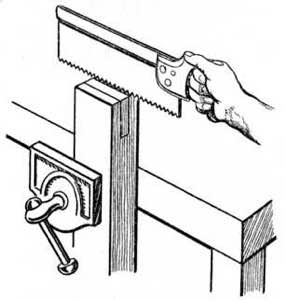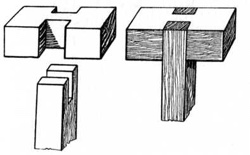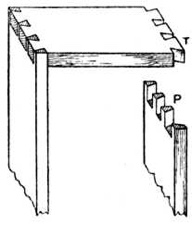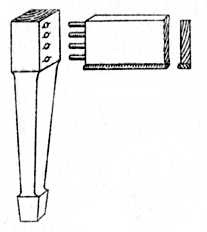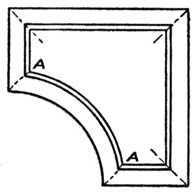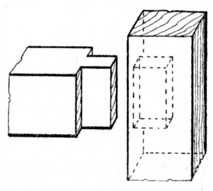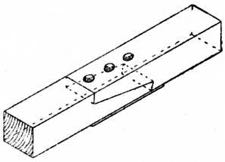|
|
Bridal Joint
Often defined as a reverse mortise and tenon, the name probably originated from the resemblance to a horse's bit and bridle. |
|
|
Dovetail Joint
One day, whilst enjoying a humble meal, a "joyner"
sat watching some doves as they hopped about the yard. Struck by the
movement of their wedge-shaped tails, it occurred to him to joint his
timber by the interlocking method; hence we have dovetails. |
|
|
Dowel Joint
Dowelling is the term generally given to the method
of jointing timber and other materials by wooden or metal pegs, which
are called dowels. |
|
|
Glued Joint
Alternative names under which it
is known are the butt joint, the rubbed joint, and the slipped joint.
With a quality glue the joint is usually stronger than the material it
is bonding. |
|
|
Half Lap Joint
The half lap joint is also know as
a "halved" joint, basically one half of each part is cut away and the
parts fastened together. |
 |
|
Hinged Joint
Most troubles experienced by the
amateur, such as "hinge-bound," "stop-bound," and "screw-bound" doors,
etc., are due to a lack of knowledge of the principles of hingeing. |
|
|
Joints For Curved Work
Segments may be laminated or halved to make curved items. |
|
|
Mitered (Mitred) Joints
The term mitering is not confined
to the fitting of timber around a right angle; it may be justly applied
to the fitting of a moulding around an angle irrespective of the number
of its degrees. |
|
|
Mortise and Tenon
A mortise and tenon joint is the
method of joining timber by working a solid rectangular projection in
the one piece and cutting a corresponding cavity to receive it in the
adjoining piece. |
|
|
Puzzle Joints
Puzzles call for very careful
setting out and cutting, entailing the same degree of skill that is
demanded for high-class cabinet work. |
|
|
Scarf Joints
The method known as "scarfing" is
used for the joining of timber in the direction of its length, enabling
the workman to produce a joint with a smooth or flush appearance on all
its faces.
|
|
|
Shutting Joints
This page deals with the joint
made by the upright rail of a door frame which carries the lock, or
handle, generally called the "slamming stile." |
|
|
Tongued and Grooved Joint
The tongued and grooved joint is
used in one form or another from the laying of flooring boards to the
construction of dressers, bookcases and other cabinet work. |
|
|
Miscellaneous Joints
This page covers several joints found in the construction and cabinet making the trades. |
